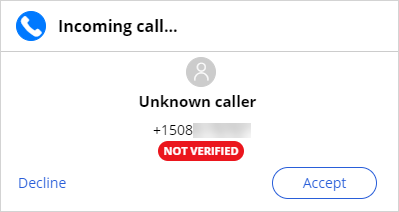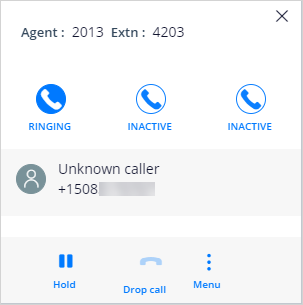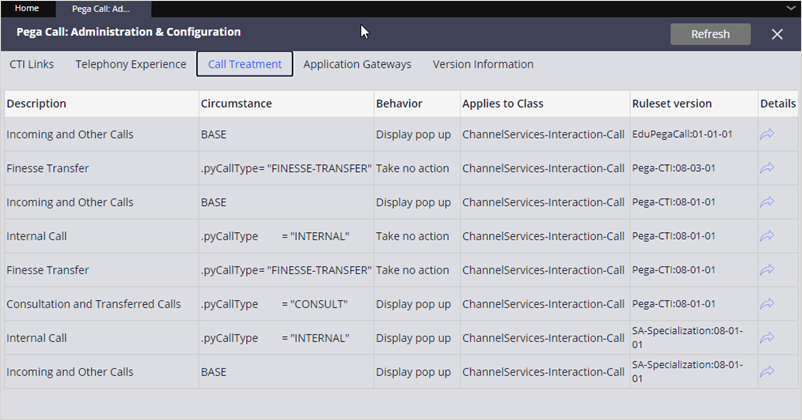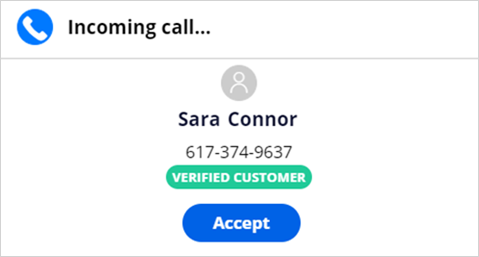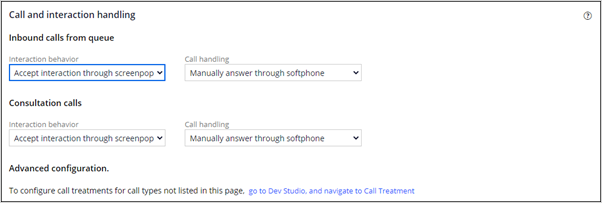
Call and interaction handling
Overview
After you configure basic call behavior in the Pega Call configuration wizard, you can further define or change the initial settings. These settings determine how an incoming call is handled on the customer service representative's (CSR) desktop.
You can use App Studio to set how a CSR answer calls and begins a customer interaction.
Call and interaction handling
In Pega Customer Service™, in App Studio, click Settings > Pega Call to configure the call settings. Then, click the Call and interaction handling tab.
Note: If the settings are not displayed, you need to make a change in the Advanced configuration. Open Dev Studio, click Configure > Channel Services > Pega Call > Administration & Configuration, and then click the Call Treatment tab. Ensure that the call treatments for Incoming and Other Calls and Consulation and Transferred Calls use the same ruleset and version.
You can set different behaviors for the two types of calls. Inbound calls from the queue represent new calls from customers. Consultation calls are those that are transferred internally, for example, transferred from a CSR to their supervisor
The Interaction behavior setting determines when to begin the customer interaction.
Accept interaction through a screen pop
In the Interaction Portal, the CSR sees the screen pop that shows the call information. The CSR clicks Accept on the screen pop to begin the customer interaction.
After the interaction begins, the CSR can access customer account details and start a service case.
Automatically start interaction
In the Interaction Portal, customer interaction begins automatically. A screen pop is not displayed.
The Call handling setting determines how and when to answer the call.
Manually answer through softphone
When a CSR has an incoming call, the Phone icon in the toolbar displays the Ringing state.
The CSR clicks the Phone icon to open the softphone, then clicks the Ringing icon to answer the call.
Automatically answer
The call is automatically answered when the CSR clicks the Phone icon in the toolbar. The softphone is displayed and the call is automatically answered. The CSR does not have to click to answer in the softphone.
Automatically answer after interaction start:
When the CSR clicks the Phone icon in the toolbar, the softphone is displayed The call is automatically answered after the customer interaction starts. The CSR does not have to click to answer in the softphone.
Advanced configuration
The settings for call and interaction handling are associated with a call treatment in Dev Studio. Use the App Studio settings shown in the previous section to configure call handling for inbound calls and consultation calls. If your organization needs to configure call handling for internal calls differently, you can make changes in Dev Studio.
To configure these settings, open Dev Studio, click Configure > Channel Services >Pega Call > Administration & Configuration, and then click the Call Treatment tab.
Call treatment tab
The Call Treatment tab displays a list of call treatment rules.
The tab shows the circumstance, behavior, class, and ruleset version for each rule.
The Circumstance field indicates the type of call to which the treatment applies. For example, BASE indicates that the treatment applies to all incoming calls. The configuration wizard creates a call treatment for the BASE circumstance.
The tab also shows call treatment templates that you can use to create a treatment that handles different call types.
For example, the default setting for Internal calls (a CSR calling another CSR to chat about policy) is Take no action. In this case, the call does not create an interaction, and the call is answered through phone (not within the Interaction Portal).
Call treatment example
Consider an example call treatment that is created by the Pega Call configuration wizard. The following image is the Incoming and Other Calls rule for the BASE circumstance.
The settings for a call treatment affect behavior when a call is Offering, which means that the CSR has an incoming call.
The Display pop up option causes the treatment to display a screen pop when a call is offered. In the Interaction Portal, the CSR sees the screen pop that shows the call information. The CSR clicks Accept on the screen pop to begin the customer interaction.
After the interaction begins, the CSR can access customer account details and start a service case.
In the example, the Timeout disposition setting closes the screen pop if the interaction does not start after 10 seconds.
In the example call treatment, Auto answer is set to Never, so the CSR must answer the call with the softphone.
The CSR clicks the Ringing icon to answer the call.
Call treatment settings
The treatment settings that you select depend on the call center requirements and the CTI capabilities. The following table displays the possible settings and associated behaviors for treatments:
|
Call Treatment |
Timeout Disposition |
Auto Answer |
Wait Until |
Interaction Portal Behavior |
|
Take no action |
N/A |
N/A |
N/A |
|
|
Display pop up |
Start the interaction |
Never |
N/A |
|
|
Display pop up |
Close the window |
Never |
N/A |
|
|
Display pop up |
Take no action |
Never |
N/A |
|
|
Display pop up |
Start the interaction |
Always |
Don't wait |
|
|
Display pop up |
Close the window |
Always |
N/A |
|
|
Display pop up |
Take no action |
Always |
Don't wait |
|
|
Display pop up |
Start the interaction |
Always |
Wait until the interaction is started |
|
|
Display pop up |
Close the window |
Always |
Wait until the interaction is started |
|
|
Display pop up |
Take no action |
Always |
Wait until the interaction is started |
|
|
Automatically start an interaction |
Start the interaction |
Never |
N/A |
|
|
Automatically start an interaction |
Ignore the interaction request |
Never |
N/A |
|
|
Automatically start an interaction |
Start the interaction |
Always |
Don't wait |
|
|
Automatically start an interaction |
Ignore the interaction request |
Always |
Don’t wait |
|
|
Automatically start an interaction |
Start the interaction |
Always |
Wait until the interaction is started |
|
|
Automatically start an interaction |
Ignore the interaction request |
Always |
Wait until the interaction is started |
|
|
Automatically start an interaction and display pop up |
N/A |
Never |
N/A |
|
|
Automatically start an interaction and display pop up |
N/A |
Always |
Don't wait |
|
|
Automatically start an interaction and display pop up |
N/A |
Always |
Wait until the interaction is started |
|
Treatment modification
To change the call behavior, you can check out the call treatment, change the settings, and then save the treatment.
In the example treatment, if you change the main action from Display pop up to Automatically start an interaction, the call behavior on the Pega Desktop changes. In this case, the CSR does not see the screen pop, and the customer interaction automatically begins when the CSR receives the incoming call.
If you want to answer the call automatically, set Auto Answer to Always. You can also set this option to wait until the interaction begins before answering the call.
You can set a timeout for the start of the interaction. For example, if Display pop up is selected, the CSR must start the customer interaction. You can set a timeout of 20 seconds, after which the interaction begins if the CSR has not yet started it.
ANI Lookup
If your configuration does not use a voice response system, you can use Automatic Number Identification (ANI) to automatically look up an incoming caller and display the caller's information on the screen pop and in the interaction. The lookup applies only to incoming calls, such as calls from customers or potential customers. Your telephony system determines the ANI format.
To configure ANI Lookup, navigate to the Call Treatment tab, select Incoming and Other calls, and select the Enable ANI Lookup check box. Select the applicable when rule in Enable Lookup Based on this When Rule. You can set this to Always.
If a CSR receives an incoming call and the contact number is registered with a unique customer, then the customer account details are displayed on the screen pop.
If there is no match for the contact number, then the screen pop displays unknown caller and a search screen for CSRs to search for the customer record manually.
If the contact number is registered with multiple customers, the customer search screen shows all the possible matches. The CSR can select the correct customer record. For example, if a family shares phone numbers, the screen pop displays unknown caller, but the customer search shows all possible matches for that phone number.
If you are having problems with your training, please review the Pega Academy Support FAQs.
Want to help us improve this content?

